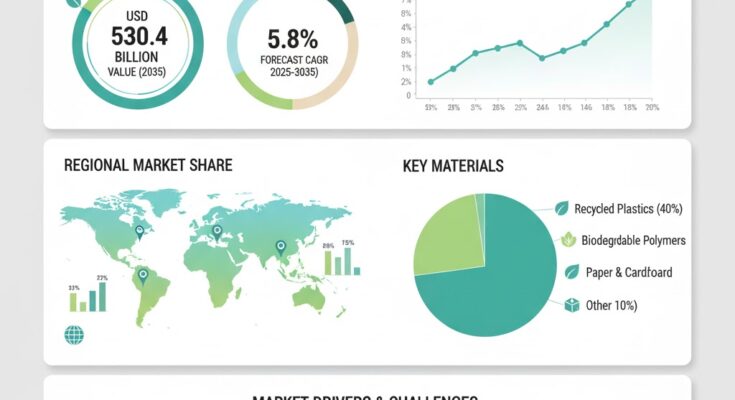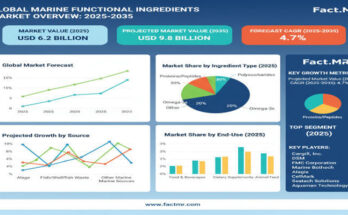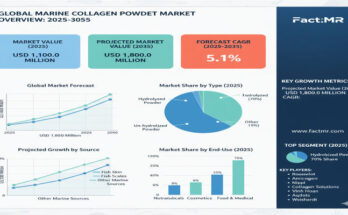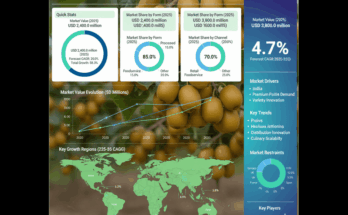The global sustainable food packaging market is gaining remarkable momentum as governments, brands, and consumers increasingly prioritize eco-friendly materials and responsible packaging practices. According to a recent report by Fact.MR, the market is projected to grow from USD 301.8 billion in 2025 to approximately USD 530.4 billion by 2035, recording an absolute increase of USD 228.6 billion over the forecast period. This reflects a total growth of 75.8%, with the market expected to expand at a CAGR of 5.8% between 2025 and 2035.
Market Overview: Sustainability Becomes the New Standard
The transition toward sustainable food packaging marks a paradigm shift in how the global food industry approaches materials, waste, and design. Increasing concerns about plastic pollution, climate change, and landfill overflow have pushed manufacturers to develop biodegradable, compostable, recyclable, and reusable packaging alternatives.
From paper-based boxes and molded pulp trays to bioplastics derived from starch and sugarcane, the industry is witnessing unprecedented diversification in material science and packaging design. As food producers align with sustainability goals and Extended Producer Responsibility (EPR) frameworks, demand for next-generation, low-impact packaging continues to soar.
Strategic Market Drivers
- Regulatory Mandates and Circular Economy Policies
Global governments and environmental agencies are tightening packaging waste regulations, promoting recycling, and restricting single-use plastics. The European Union’s Green Deal, India’s Plastic Waste Management Rules, and the U.S. EPA’s circular economy initiatives are reshaping procurement and material selection.
These regulations have accelerated the shift toward bio-based, recyclable, and compostable food packaging, compelling brands to innovate for compliance while enhancing product safety and shelf appeal.
- Consumer Demand for Eco-conscious Products
Modern consumers are making purchasing decisions based on environmental responsibility. Brands that adopt biodegradable or reusable packaging solutions gain higher brand loyalty and trust.
The foodservice and retail sectors—particularly quick-service restaurants (QSRs) and online grocery platforms—are rapidly replacing plastic containers and films with paper, PLA-based, and fiber-based alternatives to appeal to environmentally aware customers.
- Technological Advancements in Sustainable Materials
Breakthroughs in material engineering are enabling smart, lightweight, and barrier-enhanced packaging that maintains product freshness while reducing environmental footprint.
Innovations such as water-based coatings, plant-derived polymers, and nanocomposite films are helping manufacturers achieve both functionality and sustainability—without compromising on food safety or performance.
- Expanding Food Delivery and E-commerce Ecosystems
The exponential growth of online food delivery and grocery platforms has created demand for durable yet sustainable packaging.
To meet this surge, packaging companies are developing compostable takeaway boxes, leak-proof fiber trays, and recyclable pouches, offering sustainable solutions for ready-to-eat, frozen, and fresh food segments.
Regional Growth Highlights
North America: Driving Change Through Innovation
North America continues to lead in R&D and adoption of advanced green packaging technologies. The U.S. and Canada are witnessing rapid growth in compostable and recyclable packaging across retail and restaurant chains. Government-backed sustainability pledges and consumer-driven brand accountability are reinforcing this trend.
Europe: Regulation-led Market Expansion
Europe remains the global frontrunner in sustainable packaging, driven by stringent environmental policies and the EU’s circular economy roadmap. Countries such as Germany, France, and the Netherlands are prioritizing closed-loop recycling systems, leading to widespread use of fiber-based and bio-based materials.
Asia Pacific: Emerging as a High-potential Region
Asia Pacific is set to witness robust expansion, led by China, India, and Japan. Rapid urbanization, booming food delivery sectors, and growing awareness about plastic pollution are encouraging companies to adopt eco-friendly packaging alternatives. Government bans on single-use plastics further fuel regional adoption.
Latin America and the Middle East: Rising Adoption of Green Packaging
Emerging economies are embracing sustainable packaging as part of broader environmental reforms. Investments in bio-polymer manufacturing and composting infrastructure are on the rise, especially in Brazil, Mexico, and the UAE, presenting new growth opportunities for packaging suppliers.
Challenges and Market Considerations
Despite promising growth, the market faces challenges such as:
- High Cost of Sustainable Materials: Eco-friendly alternatives remain more expensive than conventional plastics.
- Infrastructure Gaps in Recycling: Limited composting and collection systems hinder large-scale adoption.
- Performance Trade-offs: Biodegradable materials may lack the same durability or barrier protection as traditional plastics.
- Regulatory Complexity: Differing national standards complicate global product compliance and certification.
Competitive Landscape
The sustainable food packaging market is highly dynamic and innovation-driven, featuring collaborations across the value chain.
Key Players in the Sustainable Food Packaging Market:
- Amcor Plc
- WestRock
- International Paper
- Tetra Pak
- Sealed Air Corporation
- Berry Global
- Mondi Group
- Graphic Packaging Holding
- Ranpak Holdings
These industry leaders are focusing on biodegradable materials, lightweight designs, and recyclable solutions, while investing heavily in R&D to improve packaging efficiency and reduce environmental impact. Strategic partnerships with food producers and retailers are accelerating product adoption globally.
Maufracture’s Strategic Positioning
Maufracture is strategically positioned to capitalize on this green transformation through:
- Material Innovation: Developing next-generation biodegradable coatings and recyclable packaging films.
- Sustainability Integration: Embedding renewable energy practices and circular design principles across its operations.
- Collaborations with FMCG and Foodservice Leaders: Co-developing sustainable packaging solutions that align with global brand sustainability goals.
- Geographic Expansion: Strengthening its footprint in Asia Pacific and North America, where eco-friendly packaging adoption is accelerating.
Future Outlook: Toward a Circular and Sustainable Food Packaging Ecosystem
The next decade marks a transformative era for the food packaging industry. As sustainability shifts from an optional initiative to a global imperative, the convergence of technology, regulation, and consumer awareness will reshape market dynamics.
Manufacturers that combine environmental responsibility with innovation and scalability will lead the future of food packaging. With strong R&D capabilities and a clear sustainability vision, Maufracture is well-positioned to pioneer eco-efficient solutions—delivering smarter, cleaner, and more sustainable food packaging for the planet’s future.



